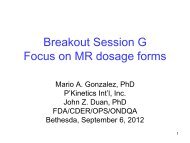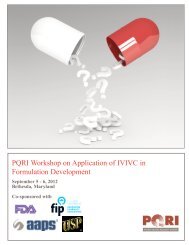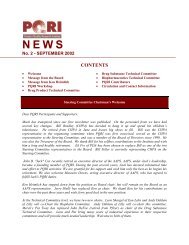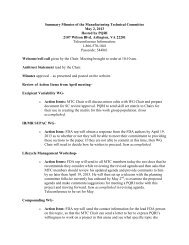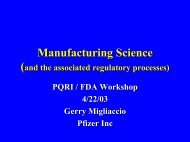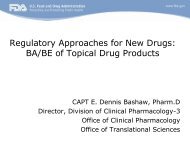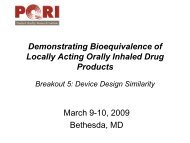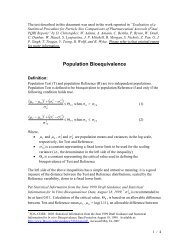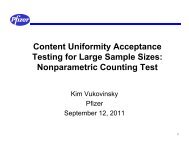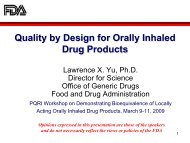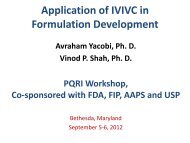Changes Without Prior Approval Breakout Session (PDF) - PQRI
Changes Without Prior Approval Breakout Session (PDF) - PQRI
Changes Without Prior Approval Breakout Session (PDF) - PQRI
You also want an ePaper? Increase the reach of your titles
YUMPU automatically turns print PDFs into web optimized ePapers that Google loves.
.<br />
Goals and Oli>jectives<br />
Discuss the following:<br />
<strong>Breakout</strong> <strong>Session</strong>: <strong>Changes</strong> <strong>Without</strong> <strong>Prior</strong> <strong>Approval</strong><br />
April 22, 2003<br />
Scientific risk-based approaches for identifying low risk manufacturing changes that cart be<br />
implemented without prior FDA approval<br />
Draft guidance on comparability protocols for small molecules and development of a<br />
comparability protocol guidance for proteins<br />
Effective use of development data and other information to justify less burdensome filing<br />
requirements for postapproval manufacturing changes<br />
Background Information<br />
Background infonIlation on the status of on-going postapproval change activities is attached.<br />
Format<br />
There will be four sessions on <strong>Changes</strong> <strong>Without</strong> <strong>Prior</strong> <strong>Approval</strong>. The intended format of the<br />
workshop is for all participants from one of the four business sectors (generic-human drug,<br />
innovator-human drug, animal drug, and biotechnology) to attend their assigned session. The<br />
discussions will be in a brain-storming format.<br />
Focus<br />
While it is important to recognize and understand current and past initiatives relating to<br />
postapproval changes, the breakout sessions are intended to focus on new opportunities and<br />
pathways. The breakout sessions will focus on four basic areas:<br />
1 For postapproval changes, how do you define risk How do you manage the risk What<br />
risk-based approaches can you suggest for identifying low risk postapproval changes, drugs,<br />
or manufacturing processes<br />
Real or perceived risks are associated with any decision making/change process.<br />
Furthermore, there are risks in not changing. We will explore how risk is viewed and<br />
managed for postapproval changes.<br />
Do you see comparability protocols as being useful to your company Have you used<br />
comparability protocols in the past Do you have an example of how one was successfully<br />
used<br />
FDA has recently published a guidance on comparability protocols<br />
(http://www.fda.gov/cder(gyidance/5427dft.ndf). We will discuss how comparability protocolSi
might be used in a company and to justify less burdensome filing requirements for<br />
postapproval changes.<br />
3. How could development data and other information be used to justify less burdensome ~ling<br />
requirements for postapproval changes<br />
i<br />
A firm, through its development program, often has an in-depth understanding of how I<br />
chemistry, manufacturing, and controls changes can affect its product. This informatioq, if<br />
shared with regulators, could justify less burdensome filing requirements for changes I<br />
justified as low risk by the development data. We will explore the opportunities for usi*g<br />
development data or other information to justify less burdensome filing requirements for<br />
postapproval changes.<br />
4. In addition to the current initiatives, can you suggest other risk-based approaches to jusf: fy<br />
less burdensome filing requirements for postapproval manufacturing changes Have yo<br />
experience with other approaches (e.g., other regulatory agencies) that might be adopte for<br />
reporting postapproval changes to FDA<br />
I<br />
T~is discussion will focus on gathering suggestions for diff~rent risk-based approaches ~at<br />
mIght be used by FDA to regulate postapproval manufactunng changes.<br />
I<br />
Closing: Can you recommend any next steps Future workshops
Status-Current<br />
Postapproval Change Initiatives<br />
FDAMA 116<br />
On November 21, 1997, the President signed the Food and Drug Administration Modernization<br />
Act (FDAMA) (Pub. L. 105-115). Section 116 ofFDAMA amended the Federal Food, Drug, and<br />
Cosmetic Act (The Act) by adding section 506A (21 V.S.C. 356a), which provides requirements<br />
for making and reporting manufacturing changes to an approved application and for distributing<br />
a drug product made with such changes. Section 116 further provided that these requirements<br />
take effect upon the effective date of regulations promulgated to implement section 116 or 24<br />
months after enactment of this provision, whichever occurs first.<br />
FDAMA 116 affects CDER, CBER, and CVM. The Centers have been working together on<br />
updating general regulations and publishing guidance documents that provide more specifi~<br />
recommendations on the reporting mechanism of postapproval changes.<br />
I<br />
illER<br />
Regulation<br />
On June 28, 1999, FDA published in the Federal Register a proposed rule revising 21 CFR<br />
314.70 (64 FR 34608), with a limited number of changes updating 610.12 (CBER). Since<br />
November 21, 1999, and until the final regulation for § 314.70 publishes, section 506A is the<br />
sole basis for FDA's regulation of postapproval manufacturing changes for products approv~d in<br />
new drug (NDA) or abbreviated new drug (AND A) applications. Publication of the final rule is<br />
pending.<br />
Guidance<br />
On June 28, 1999, FDA published in the Federal Register a: notice of availability of a draft<br />
guidance entitled <strong>Changes</strong> to an ApprovedNDA orANDA (64 FR 34660). CDER issued a final<br />
guidance on <strong>Changes</strong> to an Approved NDA orANDA on November 19, 1999. Since November<br />
19, 1999 the guidance has represented FDA's current thinking on how it will apply the<br />
requirements of section 506A of the Act for NDA and ANDA products. An updated versiott<br />
(conforming changes only) of this guidance will publish with the final rule. CDER intends ~o<br />
revise the guidance with substantive changes after 314.70 publishes.<br />
Some of CDER products are covered under the CBER/CDER guidance <strong>Changes</strong> to an Apprbved<br />
Application for Specified Biotechnology and Specified Synthetic Biological Products.<br />
~<br />
Regulation<br />
CBER's postapproval regulations at 601.12 are considered consistent with FDAMA 116.<br />
However, a limited number of changes were published along with the CDER rule revising<br />
314.70 to promote consistency between the Centers. ('
GuIdance<br />
..'."':<br />
CBER's postapproval change guidances include:<br />
..";'.",,:,<br />
f.';'<br />
" :!'<br />
.<strong>Changes</strong> to an Approved Application for Specified Biotechnology and Specified Synthe ic<br />
Biological Products.<br />
<strong>Changes</strong> to an Approved Application: Biological Products: Human Blood and Blood<br />
Components Intended for Transfusion or for Further Manufacture<br />
QYM<br />
Regulation<br />
On October 1, 1999, FDA published in the Federal Register a proposed rule revising 21 CF~<br />
514.8 (64 FR 53281). Publication of the final rule is pending.<br />
Guidance<br />
On October 1, 1999, FDA published in the Federal Register a notice of availability of a draft<br />
guidance entitled <strong>Changes</strong> to an Approved NADA or ANADA.<br />
I<br />
Comparability Protocols<br />
A draft guidance (CBER/CDER/CVM) on comparability protocols published on February ~5,<br />
2003 (68 FR 8772). The comment period closes on June 25, 2003. A second comparability<br />
protocol guidance tailored to certain biologics drug products and proteins is planned.<br />
SUPAC Guidances (all CDER; limited participation by CBER, CVM)<br />
Updating of all published "SUPAC" guidances is warranted. Currently, updating of these<br />
guidances is a lower priority compared to other projects.<br />
Published Guidances<br />
BACP AC I: Inteffilediates in Drug Substance Synthesis; Bulk Actives Postapproval Ch f ges:<br />
Chemistry, Manufacturing, and Controls Documentation (CDER/CVM)<br />
PAC-ATLS: Postapproval <strong>Changes</strong> -Analytical Testin,g<br />
SUPAC-IR: Immediate-Release Solid Oral Dosage FOffilS: Scale-Up and Post-<strong>Approval</strong>!<br />
<strong>Changes</strong>: Chemistry, Manufacturing and Controls, In Vitro Dissolution Testing, and In Vivo<br />
Bioequivalence Documentation<br />
SUPAC-IR/MR: Immediate Release and Modified Release Solid Oral Dosage FOffilS<br />
Manufacturing Equipment Addendum<br />
SUP AC-MR: Modified Release Solid Oral Dosage FOffilS Scale-Up and PostapprovaI<br />
<strong>Changes</strong>: Chemistry, Manufacturing, and Controls; In Vitro Dissolution Testing and In ivo<br />
Bioequivalence Documentation<br />
..<br />
2
SUP AC-SS: Nonsterile Semisolid Dosage Fonns; Scale-Up and Post-<strong>Approval</strong> <strong>Changes</strong>:<br />
Chemistry, Manufacturing and Controls; In Vitro Release Testing and In Vivo<br />
Bioequivalence<br />
Planned Guidances<br />
APP AC: Analytical Procedures; Post <strong>Approval</strong> <strong>Changes</strong><br />
BACP AC II: Intennediates in Drug Substance Synthesis; Bulk Actives Postapproval<br />
<strong>Changes</strong>: Chemistry, Manufacturing, and Controls Documentation (CDER/CVM)<br />
P ACP AC: Packaging; Post <strong>Approval</strong> <strong>Changes</strong><br />
Risk-Based CMC Review Program (CDER)<br />
A background paper on this initiative that was prepared fof' a June 2001 workshop is provided<br />
(see attached file).<br />
Note: The published guidances mentioned in this document can be found on the Internet<br />
at:<br />
CDER: ht!p;://www .fda.gov/cder/guidance/index.htm<br />
CBER: h!!Q://www .fda. gov/cber/gyidelines.htm<br />
CVM: ht!p;://www.fda.gov/cvrn/gyidance/guidance.html<br />
C:\Data\My Documents\StatusP AC2.doc<br />
..<br />
...<br />
3
Risk-Based CMC Review Program<br />
(Reducing CMC Filing Requirements for Drugs of Low Risk with respect to<br />
Quality)<br />
Sunlmary of a New CDER Initiative (updated 1-28-01)<br />
1 Objectives<br />
a) Elimination of most NDAI ANDA manufacturing supplements for low risk drugs:<br />
All CMC crumges except those listed in FDAMA section 116* (i,e., changes of<br />
Drug Substa:tlce (DS)/Drog Product (DP) specifications and DP<br />
components/compositions, and changes requiring an in-vivo study) will be<br />
reported through the AR of an approved NDAI ANDA for those low risk drugs<br />
that are On a list to be published in an Agency Guidance. However, for sterile<br />
productS on the list, changes to the sterilization process will continue to be filed in<br />
accordance "Yith existing post approval changes (PAC) guidance (i.e., submission<br />
of supplemcllts may !lot be waived for cc:ItaiI1 changcs affccting stcrilization<br />
assurance).<br />
I'<br />
b) The AIlnuall{eport (AR) ofan approved NDAiANDA for those low risk drugs on<br />
the published list will contain reduced CMC information and data. The content of<br />
such AR wiI be descn"bed in an Agency Guidance (See item 3).<br />
c) An o~gina1 ANDA for those low risk dmgs on the published list will consist of<br />
the same red'llced CMC information and data as required for the AR of the<br />
approved NI)A/ANDA for the same drug (See item (b) above). Such an ANDA<br />
will be calle
Synthetic I>rocess<br />
Physical Property<br />
Stability<br />
Manufac. History<br />
Others<br />
detemIined by common analytical tools. containing<br />
no or low # of chiral centers), others (to be defined)<br />
Simple process (a well~<br />
defined/optimized/repeatable process, others).<br />
others (to be defined)'<br />
Adequate specifications (ICH sta.adards), impurities<br />
and degradants described, known not to contain<br />
toxic impurities, othe~ (to bc defined)<br />
Polymorphism (defined and controlled), Particle<br />
sizes (defined and controllable). others (to be<br />
defined)<br />
Stable substances (long shelf life. stable under<br />
accelerated/stressed conditions not requiring<br />
special packaging, others)<br />
# of years (or # batches made) on the market<br />
(SUPACs definition), reprocessing/rework records,<br />
I.lcWUIJ:;u~Liug rcpIudut;ibility UVf:! /I I.Jfyc;aI:;, ICH<br />
Q7A. others (to be defmed)<br />
To be defined<br />
(ii)<br />
Drug PrOtiuct:<br />
Attribut~<br />
Dosage fc)rm<br />
Manufac Process<br />
Quality<br />
Stability<br />
Manufac. HiStory"<br />
AcceDtance Criteria<br />
Oral dosage form (~ediate Release, solid and<br />
liquid), including simple sterile solutions<br />
excluding low strength drugs others (to be<br />
defined)<br />
Easy to manufacture, robust/~roducible process,<br />
been manufactured. by multiple processes<br />
excluding sterilization process others (to be<br />
defined)<br />
Adequate specifications (ICH standards), impurities<br />
and degraciants well defined, others (to be defined)<br />
Stable products (long she1flife, stable under<br />
accelerated/stressed conditions not requiring<br />
special packaging, othern)<br />
# of Years (or # of batches made) on the market<br />
(SUP AC definitions), reprocessing/rework records,<br />
demonstrating reproducibility over # of years,<br />
others (to be defined)<br />
To be defined<br />
(1» Second phase: To evaluate based on its clinical usage and safety the list of drugs<br />
that meeting low risk criteria with respect to quality. Clini~ concerns may include but<br />
not limited to narrow therapeutic drugs, or drugs for critical care or with high toxicity
(e.g., certain cancer drugs). Drugs with serious clinical concerns will be removed from<br />
the list.<br />
(c) Third phase: To determine the eligibility of a manufacturer for the program based<br />
on cGMPs consideration. Examples of attributes and acceptance criteria for cGMPs<br />
consideration are:<br />
At!;ri~<br />
Manufac. History<br />
DS Manufacturer<br />
DP !',fanufacturer<br />
Others<br />
AcceDtance Criteria<br />
No recall due to quality reason No conswner<br />
complaints on quality others (to be defined)<br />
Acceptable cGlvIP status/record (to be defined)<br />
Acceptable cGMP status/record (to be defined)<br />
(To be defined)<br />
3. The content of AR and TANDA: To draft a Guidance describing the reduced CMC<br />
information and data to be submitted at a one-time basis to the AR of the approved<br />
NDA/ ANDA for the listed drugs. Such information and data may be modeled after<br />
Quality Summary of CTD-Q (e.g., a flowchart of synthetic process in lieu of detailed<br />
description, structure characterization, identification and qualification of impurities<br />
(monograph and new), composition and components ofDP, DS and DP specifications,<br />
etc.). Reporting sub~;equent CMC changes under a supplement (See l.a above) or in next<br />
AR will be limited (~nly to those changes affecting the information and data provided in<br />
the updated AR. 111e same reduced CMC information and data required for an AR will<br />
be adequate for a fANDA lor tile same lIsted c1rug.<br />
3. Under this progJaID., the following requirements are not changed:<br />
a) There will be no reduction on the requirements of validations, assessment studies,<br />
supporting data, and docwnentation that manufacturers need to perfonn or generate so to<br />
ensurc tbc idcntity, pwity, ~~ngt]J/pol.c:n~y, and qwility of thc produ~t. Thesc data and<br />
documentation will be kept on site and available for FDA inspection.<br />
b) There will be 110 change to the Pre-<strong>Approval</strong>lnspcctiol1 program for TANDA
('<br />
4. To implementhe program successfully, the Agency will<br />
a) provide training 10 industry and reviewers,<br />
b) form joint inspection team (reviewer and Field investigator) to randomly audit the<br />
scientific and valIdation data of those products regulated under this prognun, and<br />
c) work through CDER's Product Quality Research and <strong>PQRI</strong> to modify the<br />
"attributes and acceptance criteria", and to expand the drug list expanded in<br />
future.<br />
Filename: Chiu/BgdAAPS.1-28-0 1<br />
"



